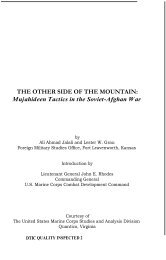hindustani fanatics, india's pashtuns, and deobandism â connections
hindustani fanatics, india's pashtuns, and deobandism â connections
hindustani fanatics, india's pashtuns, and deobandism â connections
- No tags were found...
Create successful ePaper yourself
Turn your PDF publications into a flip-book with our unique Google optimized e-Paper software.
Hindustani Fanatics, India’s Pashtuns, <strong>and</strong> Deob<strong>and</strong>ism – Connectionsa disciplined army of Hindustani sepoys. The crisis roused these chiefs to the preservation of their liberties, <strong>and</strong> they first expelled Saiad MubarakShah, the son of the late king, <strong>and</strong> then the refugees of the 55 th Native Infantry, who were conducted by the disciples of the Akhund through mountainpaths to the River Indus, which they crossed at a point far above our territory, with the desperate design of making their way to Kashmir <strong>and</strong> seekingan asylum with Maharaja Gulab Singh but they were destroyed before they arrived at their destination.A few of the sepoys of the 55 th regiment had, however, shrunk from encountering the perils of the journey to Kashmir, <strong>and</strong> had joined the youngSaiad Mubarak Shah, who had taken up his abode at the village of Panjtar. Not far from this village, at a place called Mangal Thana, a settlement ofthe Hindustanis under some mauleis of the Wahhabi sect had spring up, being a branch of the parent colony at Sittana. Mukarrab Khan, chief of theKhudu Khel tribe, who succeeded to the position of khan on the death of his father Fateh Khan in 1841, was also hostile to us. In 1837 his cousinMobaraz Khan invited the Hindustani Fanatics under Maulvi Inayat Ali Khan to his village of Chinglai.It was at this time that some of the border villages began to give way to the influences by which they were tempted to disaffection, <strong>and</strong>having refused to pay their revenue, they appealed to Mobaraaz Khan of Chinglai <strong>and</strong> the Hindustanis to come down <strong>and</strong> begin a war for Islam. Thedefaulting village of Shekh Jana was accordingly occupied by 250 men from Chinglai.On this being reported Major Vaughn, 5 th Punjab Infantry, comm<strong>and</strong>ing at Mardan, moved out on the 1 st July 1857, with a small force ofcavalry <strong>and</strong> infantry, <strong>and</strong> attacked Shekh Jana, <strong>and</strong> with slight loss to our side drove out the enemy <strong>and</strong> pursued them to the foot of the hills.A fortnight after the affair of Shekh Jana, the Hindustani Fanatics, under the leadership of Maulvi Inayat Ali Khan, crossed the border <strong>and</strong>raised the st<strong>and</strong>ard of religious warfare at the mountain village of Narinji (see map). Narinji is on the extreme border, <strong>and</strong>, being very difficult ofaccess, had become an asylum for bad characters, <strong>and</strong> had several times defied the authorities in Yusafzai; at the last moment, however, the malikshad always hitherto saved the place from destruction by submission <strong>and</strong> reparation. The villagers were proud that the place had more than once beenattacked by a Sikh force without success.The number of Hindustani followers with the Maulvi was about 150 people <strong>and</strong> he had also some 30 or 40 of the men of the late 55 th NativeInfantry. The fighting men of Narinji were about 400, <strong>and</strong> 40 horsemen had joined the party from Panjtar, under the brother of Mukarrab Khan. Afew horsemen had also come down from Swat, <strong>and</strong> several of the fugitives from Shekh Jana were with the Maulvi.On the night of the 18 th July 1857, a force of 700 infantry, a troop of cavalry, four guns, <strong>and</strong> some mounted levies <strong>and</strong> police, under thecomm<strong>and</strong> of Major Vaughan marched from Mardan with the object of surprising Narinji. The village was sighted at daylight on the morning of the21 st . The surprise was complete, the enemy making such hasty preparations as were possible after the troops were seen.The position of the village was very strong. It was built in terraces, <strong>and</strong> situated at the foot of a precipitous hill, the spurs of which surroundedit on three sides; but in the front the ground was open <strong>and</strong> practicable for cavalry. A broad s<strong>and</strong>y nala ran along the foot of the hill, on the other sideof which nala, facing Narinji, was another range of heights. The slopes of the hill above Narinji were very steep, though practicable for infantry.Tribal Analysis Center, 6610-M Mooretown Road, Box 159. Williamsburg, VA, 23188
















